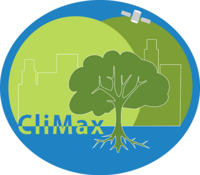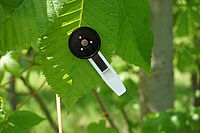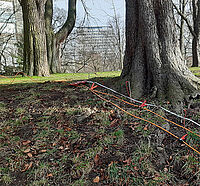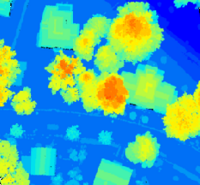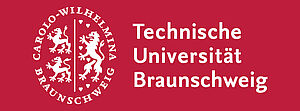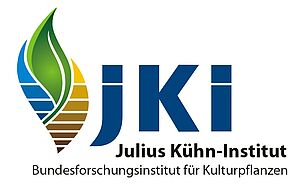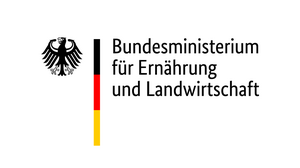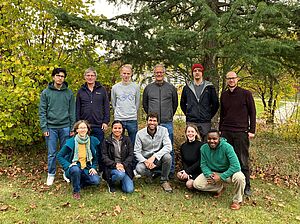Inhalt: Project CliMax
Maximizing carbon sequestration in urban trees (CliMax)
The project “Maximizing the carbon sequestration in urban trees (CliMax): Developing knowledge and tools for climate change mitigation and adaptation with multifunctional urban green infrastructure” is a collaboration between the JKI Institute for Plant Protection in Horticulture and Urban Green, the JKI Institute for Strategies and Technology Assessment, and the Technische Universität Braunschweig with the Institute of Geoecology and the Institute of Geophysics and Extraterrestrial Physics.
Project plan
Project duration: 10/2022- 09/2025
Trees have the ability to capture carbon. Stress and disease lead to less growth, and consequently less carbon is stored. Therefore, trees need to be vital to sequester carbon long-term. The water supply is one of the central factors for the vitality of the trees. To investigate the water status of individual trees and tree sites, soil and soil water conditions are studied using non-destructive geophysical methods such as ground-penetrating radar and geoelectrical methods. Stable water isotope analysis from the tree and the tree pits provide information on the depth from which trees take up water via their roots.
Urban tree vitality is regularly assessed and the data is collected in the tree cadaster. The tree cadasters of the cities of Brunswick and Brandenburg an der Havel are used for the development of an automated detection method of damaged trees. This will be based on Sentinel-2 data (for calculating vegetation indices and a subpixel analysis) and LiDAR data (single tree detection and derivation of structural features). Publicly available data characterizing tree sites will be combined in a machine learning approach to create a quality and risk assessment of the tree sites. The fusion of both methods should allow conclusions about the relationship between site conditions, and current and future tree vitality. The remote sensing tree vitality classification will be validated at selected tree sites. To do so, the biomass and growth rate of the trees are estimated with high-resolution terrestrial laser scanning. The vitality is determined through visual assessments of the crown architecture, crown expansion and plant damage.
While the observation of the biomass and growth rates allow statements about chronic stress for the trees, the project also investigates early or temporary stress symptoms on the trees. These stress symptoms are assessed through the measurements of the chlorophyll fluorescence and chlorophyll content. Detecting stress symptoms early could help green space agencies in their management decisions and thus assist to secure tree vitality. A decision matrix will be developed to illustrate the development processes of multifunctional, resilient urban tree plantation. This decision tool should support cities and municipalities to estimate the status quo of the urban tree's contribution to carbon sequestration, and maximize the climate benefits of urban green.
The CliMax project is funded by the German Climate Action Program 2022. The project aims to make a scientific contribution to climate reporting and impact assessments.
The project is divided into the following sub-areas:
Terrestrial biomass estimation and urban tree vitality analysis
Trees are a central element of urban green infrastructures. Trees store carbon in their biomass and we approximate biomass of selected trees with terrestrial laser scanning. For long-term carbon capture and sequestration, trees need to be healthy. Therefore, we study the vitality of the trees with visual tree inspections and monitor early stress symptoms. We use chlorophyll fluorescence and chlorophyll content measurements to detect early stress symptoms on selected trees. For the tree selection, we analyzed the municipal tree cadaster.
-> more ...
Water-soil-tree continuum
Water supply is a key factor for urban trees. A changing climate and the sealing of surfaces increasingly reduce water availability for urban trees. However, sufficient water supply is of great importance for the vitality and associated ecosystem services of the trees. Water uptake and associated carbon sequestration will therefore be monitored in detail at selected urban sites. The water availability is continuously recorded on individual urban trees and is extended by geophysical methods such as geoelectrics and georadar to monitor a larger area.
-> more ...
Remote sensing tree analysis
In addition to the labor-intensive measurement campaigns carried out in CliMax at selected sites, airborne laser scan data will be used for individual tree detection and to determine structural characteristics for the entire urban area.
Based on this, a remotely sensed vitality estimate of urban trees will be made based on vegetation indices from optical satellite data.
Partners
Contact
Project leadership
Dr. Mona Quambusch
Julius Kühn-Institut (JKI), Institute for Plant Protection in Horticulture and Urban Green
mona.quambusch (at) julius-kuehn.de
03946-47 7718
Project initiator: Dr. Falko Feldmann
Julius Kühn-Institut (JKI), Institute for Plant Protection in Horticulture and Urban Green
falko.feldmann (at) julius-kuehn.de
Project coordination
Vera Hörmann and Dr. Michael Strohbach
Julius Kühn-Institut (JKI), Institute for Plant Protection in Horticulture and Urban Green
CliMax (at) julius-kuehn.de
vera.hoermann (at) julius-kuehn.de
03946-47 7748
Und
michael.strohbach (at) julius-kuehn.de
03946-47 7720


